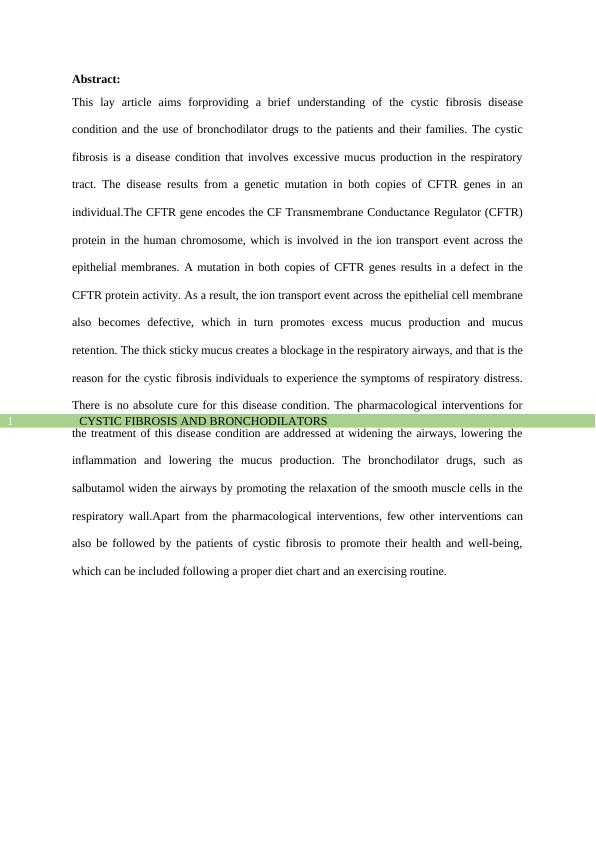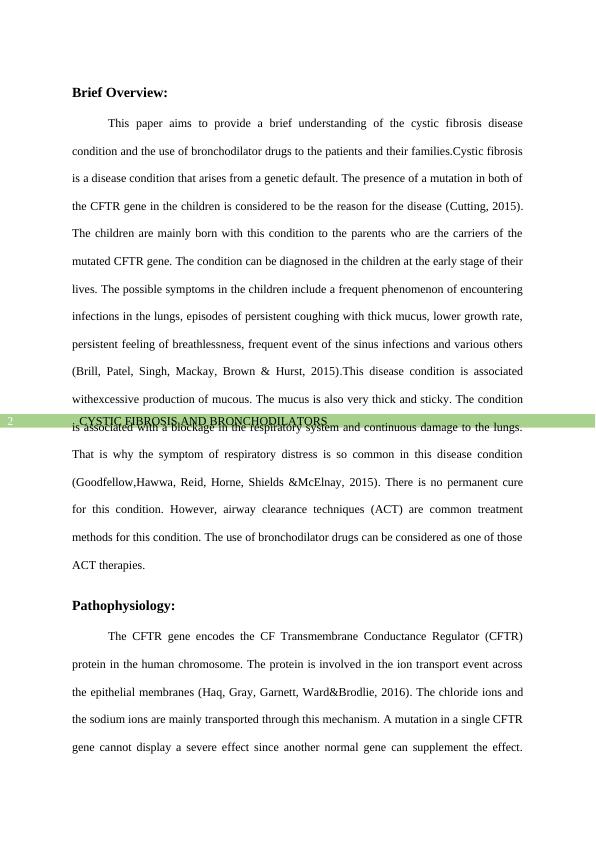Cystic Fibrosis and Bronchodilators Article 2022
Added on 2022-09-15
11 Pages2980 Words17 Views
Running head: CYSTIC FIBROSIS AND BRONCHODILATORS
CYSTIC FIBROSIS AND BRONCHODILATORS
Name of the Student:
Name of the University:
Author Note:
CYSTIC FIBROSIS AND BRONCHODILATORS
Name of the Student:
Name of the University:
Author Note:

CYSTIC FIBROSIS AND BRONCHODILATORS1
Abstract:
This lay article aims forproviding a brief understanding of the cystic fibrosis disease
condition and the use of bronchodilator drugs to the patients and their families. The cystic
fibrosis is a disease condition that involves excessive mucus production in the respiratory
tract. The disease results from a genetic mutation in both copies of CFTR genes in an
individual.The CFTR gene encodes the CF Transmembrane Conductance Regulator (CFTR)
protein in the human chromosome, which is involved in the ion transport event across the
epithelial membranes. A mutation in both copies of CFTR genes results in a defect in the
CFTR protein activity. As a result, the ion transport event across the epithelial cell membrane
also becomes defective, which in turn promotes excess mucus production and mucus
retention. The thick sticky mucus creates a blockage in the respiratory airways, and that is the
reason for the cystic fibrosis individuals to experience the symptoms of respiratory distress.
There is no absolute cure for this disease condition. The pharmacological interventions for
the treatment of this disease condition are addressed at widening the airways, lowering the
inflammation and lowering the mucus production. The bronchodilator drugs, such as
salbutamol widen the airways by promoting the relaxation of the smooth muscle cells in the
respiratory wall.Apart from the pharmacological interventions, few other interventions can
also be followed by the patients of cystic fibrosis to promote their health and well-being,
which can be included following a proper diet chart and an exercising routine.
Abstract:
This lay article aims forproviding a brief understanding of the cystic fibrosis disease
condition and the use of bronchodilator drugs to the patients and their families. The cystic
fibrosis is a disease condition that involves excessive mucus production in the respiratory
tract. The disease results from a genetic mutation in both copies of CFTR genes in an
individual.The CFTR gene encodes the CF Transmembrane Conductance Regulator (CFTR)
protein in the human chromosome, which is involved in the ion transport event across the
epithelial membranes. A mutation in both copies of CFTR genes results in a defect in the
CFTR protein activity. As a result, the ion transport event across the epithelial cell membrane
also becomes defective, which in turn promotes excess mucus production and mucus
retention. The thick sticky mucus creates a blockage in the respiratory airways, and that is the
reason for the cystic fibrosis individuals to experience the symptoms of respiratory distress.
There is no absolute cure for this disease condition. The pharmacological interventions for
the treatment of this disease condition are addressed at widening the airways, lowering the
inflammation and lowering the mucus production. The bronchodilator drugs, such as
salbutamol widen the airways by promoting the relaxation of the smooth muscle cells in the
respiratory wall.Apart from the pharmacological interventions, few other interventions can
also be followed by the patients of cystic fibrosis to promote their health and well-being,
which can be included following a proper diet chart and an exercising routine.

CYSTIC FIBROSIS AND BRONCHODILATORS2
Brief Overview:
This paper aims to provide a brief understanding of the cystic fibrosis disease
condition and the use of bronchodilator drugs to the patients and their families.Cystic fibrosis
is a disease condition that arises from a genetic default. The presence of a mutation in both of
the CFTR gene in the children is considered to be the reason for the disease (Cutting, 2015).
The children are mainly born with this condition to the parents who are the carriers of the
mutated CFTR gene. The condition can be diagnosed in the children at the early stage of their
lives. The possible symptoms in the children include a frequent phenomenon of encountering
infections in the lungs, episodes of persistent coughing with thick mucus, lower growth rate,
persistent feeling of breathlessness, frequent event of the sinus infections and various others
(Brill, Patel, Singh, Mackay, Brown & Hurst, 2015).This disease condition is associated
withexcessive production of mucous. The mucus is also very thick and sticky. The condition
is associated with a blockage in the respiratory system and continuous damage to the lungs.
That is why the symptom of respiratory distress is so common in this disease condition
(Goodfellow,Hawwa, Reid, Horne, Shields &McElnay, 2015). There is no permanent cure
for this condition. However, airway clearance techniques (ACT) are common treatment
methods for this condition. The use of bronchodilator drugs can be considered as one of those
ACT therapies.
Pathophysiology:
The CFTR gene encodes the CF Transmembrane Conductance Regulator (CFTR)
protein in the human chromosome. The protein is involved in the ion transport event across
the epithelial membranes (Haq, Gray, Garnett, Ward&Brodlie, 2016). The chloride ions and
the sodium ions are mainly transported through this mechanism. A mutation in a single CFTR
gene cannot display a severe effect since another normal gene can supplement the effect.
Brief Overview:
This paper aims to provide a brief understanding of the cystic fibrosis disease
condition and the use of bronchodilator drugs to the patients and their families.Cystic fibrosis
is a disease condition that arises from a genetic default. The presence of a mutation in both of
the CFTR gene in the children is considered to be the reason for the disease (Cutting, 2015).
The children are mainly born with this condition to the parents who are the carriers of the
mutated CFTR gene. The condition can be diagnosed in the children at the early stage of their
lives. The possible symptoms in the children include a frequent phenomenon of encountering
infections in the lungs, episodes of persistent coughing with thick mucus, lower growth rate,
persistent feeling of breathlessness, frequent event of the sinus infections and various others
(Brill, Patel, Singh, Mackay, Brown & Hurst, 2015).This disease condition is associated
withexcessive production of mucous. The mucus is also very thick and sticky. The condition
is associated with a blockage in the respiratory system and continuous damage to the lungs.
That is why the symptom of respiratory distress is so common in this disease condition
(Goodfellow,Hawwa, Reid, Horne, Shields &McElnay, 2015). There is no permanent cure
for this condition. However, airway clearance techniques (ACT) are common treatment
methods for this condition. The use of bronchodilator drugs can be considered as one of those
ACT therapies.
Pathophysiology:
The CFTR gene encodes the CF Transmembrane Conductance Regulator (CFTR)
protein in the human chromosome. The protein is involved in the ion transport event across
the epithelial membranes (Haq, Gray, Garnett, Ward&Brodlie, 2016). The chloride ions and
the sodium ions are mainly transported through this mechanism. A mutation in a single CFTR
gene cannot display a severe effect since another normal gene can supplement the effect.

CYSTIC FIBROSIS AND BRONCHODILATORS3
However, if both of the CFTR genes are defective in an individual, the CFTR protein activity
becomes defective as well. There is a defect in the ion transport event across the epithelial
cell membrane. As a result, there is a depletion in the airway surface liquid, which plays an
important role to support the ciliary function and stability. The ciliary function includes the
management of mucus in the respiratory tract and thus, a ciliary collapse result in a prolonged
mucosal retention event. The event increases the rate of infection and inflammation, which
again is associated with increased mucus production in an individual (Bergeron &Cantin,
2019). The thick sticky mucus produced by this vicious cycle creates a blockage in the
respiratory airways, and that is the reason for the cystic fibrosis individuals to experience the
symptoms of respiratory distress (Refer to Figure 1).
Figure 1: Pathophysiology of Cystic Fibrosis
Source: (Firth et al., 2015)
However, if both of the CFTR genes are defective in an individual, the CFTR protein activity
becomes defective as well. There is a defect in the ion transport event across the epithelial
cell membrane. As a result, there is a depletion in the airway surface liquid, which plays an
important role to support the ciliary function and stability. The ciliary function includes the
management of mucus in the respiratory tract and thus, a ciliary collapse result in a prolonged
mucosal retention event. The event increases the rate of infection and inflammation, which
again is associated with increased mucus production in an individual (Bergeron &Cantin,
2019). The thick sticky mucus produced by this vicious cycle creates a blockage in the
respiratory airways, and that is the reason for the cystic fibrosis individuals to experience the
symptoms of respiratory distress (Refer to Figure 1).
Figure 1: Pathophysiology of Cystic Fibrosis
Source: (Firth et al., 2015)

End of preview
Want to access all the pages? Upload your documents or become a member.
Related Documents
Pharmacology of Ivacaftor: Mechanism of Action and Pharmacokineticslg...
|7
|2392
|78
CFTR Gene and its Defects | Essaylg...
|3
|454
|32
cystic Fibrosis Assignment PDFlg...
|8
|1489
|158
Assignment On Nursing Care Plan.lg...
|8
|1255
|12
Nursing and Case Study | Assignmentlg...
|5
|2139
|43
Pathophysiology of Cystic Fibrosis PDFlg...
|15
|3364
|568
